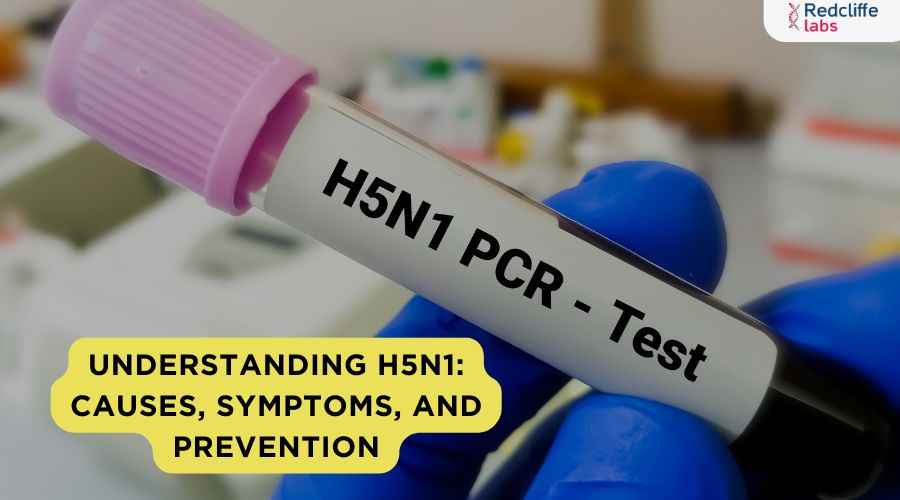Understanding H5N1: Causes, Symptoms, and Prevention

Medically Reviewed By
Prof. Ashok Rattan
Written By Muskan Taneja
on Jan 7, 2025
Last Edit Made By Muskan Taneja
on Jul 19, 2025

Did you know three tigers and a leopard at a Nagpur rescue center have died from H5N1 in India?
The H5N1 virus is a rare subtype of the virus that affects rescued wildlife in India. The Union Government has issued an advisory urging zoos nationwide to remain vigilant, follow prevention plans, and monitor captive animals for symptoms.
Healthcare professionals consider the H5N1 virus a threat to human health. The virus can spread to humans from infected animals or contaminated environments, triggering concerns.
It is important to know all about the H5N1 flu virus and take precautions to prevent it from becoming a pandemic. So, let’s begin!
What is the H5N1 Virus?
The H5N1 virus is highly contagious and can cause severe respiratory disease in birds, so experts also call it bird flu.
Bird flu is a viral respiratory disease that primarily affects birds and is transmitted to humans and animals. Bird flu H5N1 may cause fever, cough, diarrhea, stomach pain, and chest pain. The symptoms, like flu disease, making the symptoms common and even more difficult to distinguish.
The H5N1 flu virus is enzootic, i.e., species maintained in populations, but it is also panzootic, i.e., affects animals of many species over a wide area.
The full form of H5N1 is Highly Pathogenic Avian Influenza A, also known as H5N1 bird flu. It can infect mammals, including humans, who are exposed to infected birds.
The H5N1 virus in India was first identified in poultry and occurred in 2006 in Maharashtra. However, between 2006 and 2021, the states of West Bengal, Kerala, and Odisha reported most H5N1 and H5N8 outbreaks.
The H5N1 pandemic threat level in India is currently low. However, recently, the country saw an outbreak when three tigers (one tiger and two tigress) and one leopard (female) died of H5N1 at Nagpur’s Gorewada Rescue Centre in Maharashtra.
Types of Bird Flu
H5N1 is a subtype of bird flu. Many bird flues are classified by the severity of the disease in poultry and the proteins on the virus's surface.
- Low Pathogenicity Avian Influenza (LPAI)- LPAI causes little or no clinical signs in poultry.
- High Pathogenicity Avian Influenza (HPAI)- HPAI can cause severe complications, including multiple organ failure and high mortality rates in poultry.
- Subtypes—The H5N1 virus is known as avian influenza, and it is divided into subtypes, including H5, H6, H7, H9, and H10. H5N1 and H7N9 are the two most common subtypes that spread to humans.
What are the Causes of the H5N1 Virus in Humans?
A human may catch the H5N1 virus after unprotected contact with infected birds, animals, or a contaminated surface. The causes of H5N1 can be:
- Touching infected birds or animals
- Attending markets that sell live birds.
- Handling birds for sale
- Slaughtering or butchering infected poultry
- Preparing infected poultry (chicken) for cooking
- Touching or breathing in infected birds or animals' feces or other secretions (saliva).
What are the Symptoms of the H5N1 Virus?
India is at risk of an H5N1 bird flu pandemic because of its large poultry sector, wetlands, and migratory flyways.
Some symptoms of bird flu in humans include fever, cough, diarrhea, fatigue, sore throat, and respiratory issues.
The H5N1 symptoms may range from no symptoms, to mild-to-moderate symptoms. Here is a breakdown of H5N1 symptoms.
Mild Symptoms Include:
- Conjunctivitis (Eye redness and irritation)
- Mild Fever or feeling feverish
- Cough
- Sore throat
- Runny or stuffy nose
- Muscle or body aches
- Headaches
- Fatigue
- Nausea or vomiting
- Diarrhea
Symptoms of Moderate to Severe Disease
- High Fever
- Shortness of breath or difficulty breathing
- Seizures
- Altered consciousness
Who is at risk of the H5N1 Virus?
H5N1 virus doesn’t transfer spreads from a contaminated environment or infected bird (or animal) to humans. However, it doesn’t transfer from human to human.
People with jobs connected to exposure to birds or other H5N1 virus-infected animals are at greater risk of infection. Usually, these include:
- Poultry and dairy farmers and workers
- Livestock workers
- Backyard bird flock owners
- Veterinarians and veterinary staff
- Animal health responders
- Public health responders
- Dairy laboratory workers
- Food processing workers handling raw milk or other confirmed (or potentially) contaminated materials
- Hunters
- Zoo or other wild animal facility workers, including
- Aquarium workers
- Sanctuary workers
- Wild animal rehabilitation center workers
11. Slaughterhouse workers performing certain tasks on lactating dairy cattle, such as:
- Post-mortem processes, including the post-mortem inspection, handling, and transporting of viscera
- Removing and transporting udders from dairy cattle for further processing or rendering
- Unloading or handling live lactating dairy cattle for slaughter, including workers handling pens and tasks involved with ante-mortem inspection.
How To Prevent the H5N1 Bird Flu in Humans?
H5N1 virus in humans spreads from infected birds or avian influenza A virus-contaminated environments. Besides, people involved in close, prolonged, and unprotected contact with infected birds or infected animals have contaminated their secretion (excretions) like saliva, milk, or mucous are at high risk. The best way to prevent H5N1 bird flu is to avoid sources of exposure whenever possible.
- Avoid direct contact with sick or dead wild birds, poultry, and other animals, and maintain distance from them. If you must come in contact with them, wear recommended PPE Kits.
- Avoid touching surfaces or materials contaminated with the secretion of H5N1 virus-contaminated animals or birds.
- Avoid touching or consuming raw milk products, especially from animals with suspected or confirmed H5N1 bird flu.
- Choose products made with pasteurized or pasteurized milk to keep yourself and your family safe.
- Don’t work with animals who are exposed to H5N1 virus.
- If you encounter an infected person, always wash your hands with soap and water to prevent the spread.
What are the Complications of H5N1 Bird Flu?
H5N1 bird flu can cause severe illness, with a mortality rate of over 50% worldwide. Early detection of symptoms, treatment, and vaccination can help prevent health complications.
- Sepsis
- Pneumonia
- Acute Respiratory Distress Syndrome
- Brain Inflammation
- Respiratory Failure
- Multiple Organ Failure
What’s the Bird Flu Treatment in Humans?
The H5N1 virus is also known as avian influenza. The CDC recommends starting treatment as soon as possible, ideally within two days of the onset of symptoms.
- Antiviral medications- Oseltamivir, Peramivir, and Zanamivir, can help reduce the severity of the disease.
- Isolation- Home or hospital isolation is necessary for individuals with the H5N1 virus to prevent its spread.
- Rest and Fluids—To recover well, a person with the H5N1 bird flu should get plenty of rest, drink fluids, and eat a healthy and nutritious diet.
- Maintain Hygiene- People with bird flu should wash their hands with soap and water regularly.
- Symptomatic Treatment- An infected person may also need symptomatic treatment, such as monitoring for complications and fluid management.
What’s the Incubation Period of the H5N1 Virus in Humans?
The incubation period of the H5N1 virus is typically 2-5 days, up to 7 days. The symptoms period usually lies between infection and the onset of symptoms.
Is H5N1 Bird Flu a Pandemic?
The H5N1 bird flu is not a pandemic currently. However, it is a concern that can become one through various risk factors like poultry, hunting, wild birds, and contaminated surfaces. Besides, experts confirm that the H5N1 virus's inability to transmit directly between humans makes a pandemic unlikely.
The H5N1 vaccine can be the ultimate method to prevent the virus's spread in India. The country currently doesn’t have the vaccine approved for bird flu or avian influenza, but efforts are underway to develop an H5N1 vaccine for both birds and humans.
FAQs
Ques1 How Does Bird Flu Spread to Humans?
Ans1 The H5N1 virus spreads in humans after close contact with infected live or dead birds or H5N1-contaminated environments.
Ques2 What is the H5N1 virus?
Ans2 The H5N1 virus is a highly infectious respiratory disease in birds, which can spread to animals and mammals, including humans.
Ques3 What are the symptoms of the H5N1 virus in humans?
Ans3 A person affected by H5N1 virus may experience fever, cough, sore throat, muscle aches, conjunctivitis, and other non-respiratory symptoms. These symptoms can cause neurologic mutations, organ failure, and severe respiratory illnesses.
The Bottom Line
The H5N1 virus has been detected in both humans and poultry in India. Nonetheless, experts show concern but don’t consider it a pandemic. Although it’s uncommon among humans, some people, like those working at the dairy, are at higher risk for infections. Timely attention to symptoms, treatment, and precautions can prevent the spread of bird flu H5N1.



